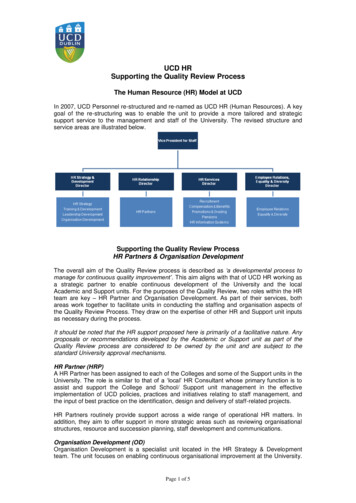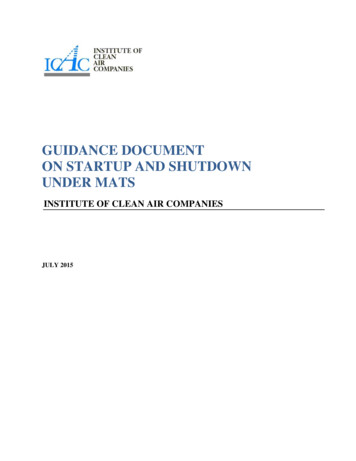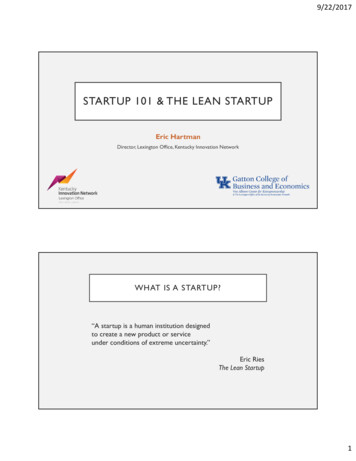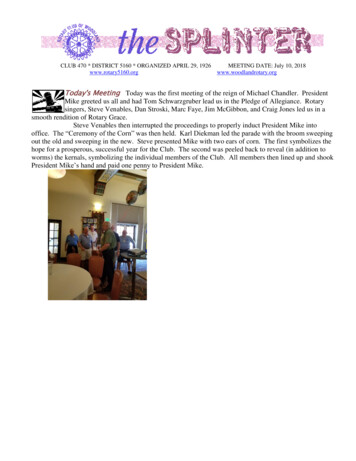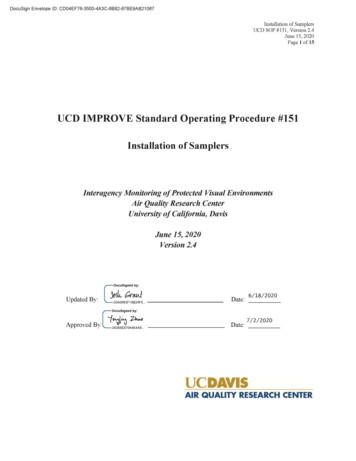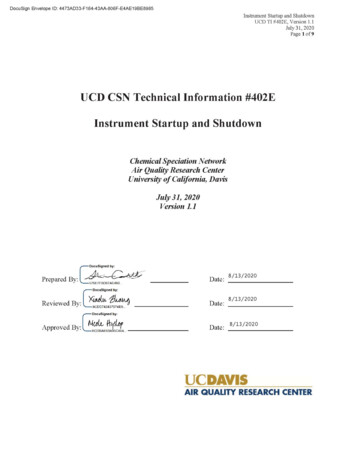
Transcription
Instrument Startup and ShutdownUCD TI #402E, Version 1.1July 31, 2020Page 2 of 9DOCUMENT HISTORYDateModifiedInitialsSection/sModifiedBrief Description of Modifications4/2/2020XZ9Minor update on terminology for consistency
Instrument Startup and ShutdownUCD TI #402E, Version 1.1July 31, 2020Page 3 of 9TABLE OF CONTENTS1.PURPOSE AND APPLICABILITY . 42.SUMMARY OF THE METHOD. 43.DEFINITIONS . 44.HEALTH AND SAFETY WARNINGS . 44.1Laser safety . 44.2Gas cylinders . 45.CAUTIONS . 46.INTERFERENCES . 47.PERSONNEL QUALIFICATIONS, DUTIES, AND TRAINING. 48.EQUIPMENT AND SUPPLIES . 49.PROCEDURAL STEPS . 510.QUALITY ASSURANCE AND QUALTY CONTROL . 911.REFERENCES . 9
Instrument Startup and ShutdownUCD TI #402E, Version 1.1July 31, 2020Page 4 of 91.PURPOSE AND APPLICABILITYThe subject of this technical information document (TI) is initial startup and shutdownprocedures in the carbon analysis laboratory.2.SUMMARY OF THE METHODProcedures for initiating and shutting down operation of carbon analysis instrumentationin the carbon laboratory.3.DEFINITIONSFlame Ionization Detector (FID): The detector used in the carbon analyzer instruments.4.HEALTH AND SAFETY WARNINGS4.1 Laser safetyThe Sunset Laboratory OCEC Carbon Aerosol Analyzers uses a 658 nm laser diodefor the optical light source during the sample analysis. While the analyzer itself isclassified as a Class 1 Laser Product — meaning there is no harmful laser radiationexposure to the operator during normal operation and maintenance — the internalsource laser diode is rated as a Class 3b product and emits sufficient optical powerto constitute a possible hazard to the human eye if directly exposed to the laserbeam. Therefore, all repair and service must be performed by a trained technician.4.2Gas cylindersIt is recommended that the lab technicians use caution when handling all supportgas cylinders and regulators, and always have cylinders properly chained to a safetyrack.NOTE: Hydrogen is a flammable gas and extra precautions should be used with thehydrogen gas lines from the supply cylinder to ensure all fittings are connected andmust be leak tested each time a new cylinder is installed. The pressure of thehydrogen gas line should be kept under 15 psi at all times.5.CAUTIONSNot applicable.6.INTERFERENCESNot applicable7.PERSONNEL QUALIFICATIONS, DUTIES, AND TRAININGOnly trained lab personnel designated by the Laboratory Manager may operateinstrumentation in the carbon laboratory.8.EQUIPMENT AND SUPPLIESNot applicable.
Instrument Startup and ShutdownUCD TI #402E, Version 1.1July 31, 2020Page 5 of 99.PROCEDURAL STEPSStart-up from full shutdown.1. Open the gas tanks and gas valves to the instrument.Open: switch is 180 , Closed: switch is 90 Each carbon analyzer has own set of gas valves.2. Check the gas cylinder pressures and record the values on the “Gas Pressure Table”.Notify lab supervisor if any leaks are detected.3. Turn on the instrument, but do not turn on the ovens.Methanator4. Open the OCEC software and place on “Standby” mode.on, the software will close. 15. Remove the FID chimney cap.1Note if the gases are notError messages will appear if the software is opened without turning on the main power first.
Instrument Startup and ShutdownUCD TI #402E, Version 1.1July 31, 2020Page 6 of 96. Open the valve values window. Click on Override Flow and set the He3 to 45 cc/min.Wait 2 minutes to purge the system. Leave all other gas flows at standby levels.7. Use the “STATUS” window to set the “Desired CH4 Oven Temperature” to 100. It willinitially read “500” and slowly decrease.8. Turn on the main oven and methanator.
Instrument Startup and ShutdownUCD TI #402E, Version 1.1July 31, 2020Page 7 of 9Methanator9. When the temperature is 100, change the desired temperature to 200. Increase thetemperature incrementally by 100 every 5 minutes until 500.10. When the temperature has stabilized at 500, click the Override Flow in the ValveValues. This will allow the gases to stabilize at the operating pressures. Allow the gasesto stabilize for 20 seconds. Minimize the “Valve Values” window and the “Status”window.11. Carefully check the plastic methanator tubing for moisture. If necessary, absorb anymoisture with laboratory wipes. 212. Take the instrument out of “Standby”.13. The instrument is now ready for analysis.14. Make sure to apply the IMPROVE A application on the software and update the“rawdata” file directory.Shutdown instructions:1. After the oven has cooled, remove the sample and put the instrument in “Standby” mode.2. Turn off the power to the methanator and main oven (upper switch on the maininstrument).Moisture can prevent the FID from igniting. If moisture is found during the heating up process, the fitting on theback end of the methanator needs to be removed to dry the area.2
Instrument Startup and ShutdownUCD TI #402E, Version 1.1July 31, 2020Page 8 of 9Methanator3. Wait for the methanator oven to cool below 100 C, which takes approximately 30-60minutes. 34. Once the ovens have cooled, close the gas flows at the valves.Open: switch is 180 , Closed: switch is 90 Each carbon analyzer has own set of gas valves5. Cover the FID chimney with the provided black plastic cap or a piece of clean foil.6. Select Exit and all off from the drop-down menu to close the OCEC1109 main software.7. Turn off the power to the instrument by switching the bottom switch off on the maininstrument.3To speed up the cooling period, partially open the methanator cover.
Instrument Startup and ShutdownUCD TI #402E, Version 1.1July 31, 2020Page 9 of 9Methanator8. Close the gas cylinders. Check the gas pressures and record the readings on the log sheetlocated on the wall in room 120A.10.QUALITY ASSURANCE AND QUALTY CONTROLNot Applicable.11.REFERENCESNot Applicable.
Instrument Startup and Shutdown UCD TI #402E, Version 1.1 July 31, 2020 Page 2 of 9. DOCUMENT HISTORY . Date Modified
